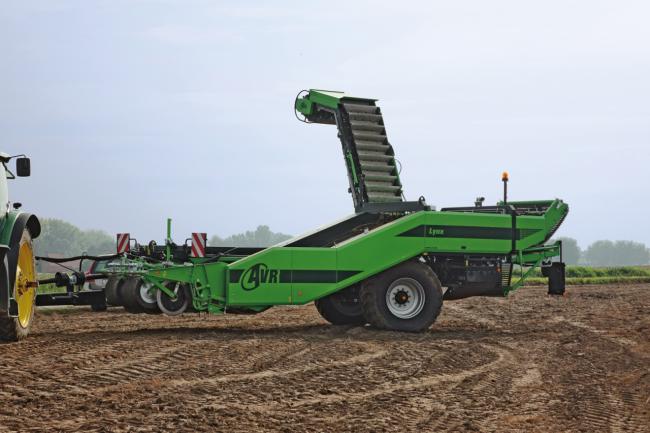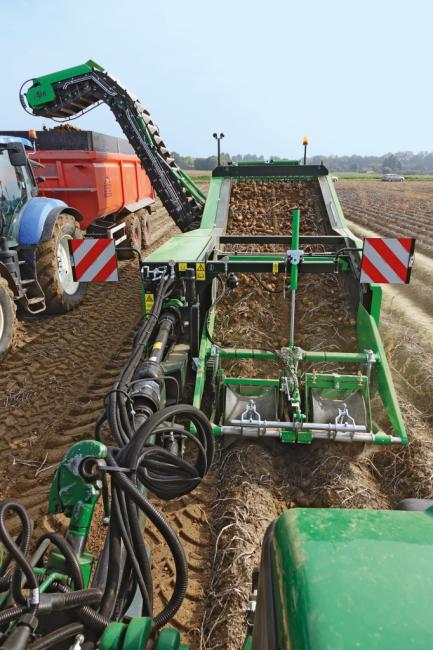Lynx
Lynx
Harvesters
Descripción
El posicionamiento de la cosechadora Lynxs AVR es único en el mercado. Esta cosechadora de dos surcos puede ser utilizada para un arranque en línea ó desplazado. Están disponibles tres tipos de módulos de limpieza: Bandas de erizo, Banda Varioweb y rodillos CR.
La máquina está enteramente accionada hidráulicamente. Un cierto número de adaptaciones bien pensadas permiten un arranque cuidadoso. La Lynx está equipada con neumáticos anchos, lo que garantiza una presión sobre el suelo menor y el arrastre fácil de la máquina.
Control mediante joystick
El joystick, que está instalado de serie en cada una de las Lynx, reúne todas las funcionalidades de base. Los parámetros de arranque pueden ser fácilmente ajustadas gracias al monitor táctil (incluido soporte de montaje). La mayoría de los componentes pueden ser ajustados hidráulicamente desde el tractor: las ruedas directrices, el nivelado de la máquina, el arrancador hacia arriba / abajo, la profundidad del arrancador hidráulicamente (en opción), el guiado (automático),entrada/salida de la banda Varioweb, la inclinación de las bandas de erizo, los cilindros del elevador, el vaciado de la banda de alimentación del elevador, la inclinación de los rodillos axiales (en opción).
Arranque desplazado rentable
Si fuera necesario, el timón puede ser fácilmente desplazado hidraúlicamente, lo que la convierte en una cosechadora de arranque desplazado.En ese caso el tractor puede montar neumáticos anchos:
- Un arranque rentable, e incluido en condiciones difíciles.
- Tratamiento delicado del suelo: una tracción superior y roderas menos profundas gracias a los neumáticos anchos.
- Los caballones ya no son más apastados ya que el tractor no rueda por encima.
- La tierra por delante de la cosechadora permanece ligera (sin terrones), lo que facilita el tamizado.
Gracias al guiado automático (de serie), el guiado está enteramente soportado. Ello garantiza un control y un guiado perfectamente ergonómicos de la máquina.


Visibilidad del proceso de arrancado
El bastidor delantero se caracteriza por su ancha entrada, sus grandes ruedas de hierba y sus diábolos de plástico. El ajuste central de la profundidad puede efectuarse con la ayuda de una simple manivela (ajuste hidráulico de la profundidad en opción a través de la pantalla). El bastidor delantero es oscilante lo que junto con el sistema de guiado automático garantizan que los caballones estás escrupulosamente recorridos, particularmente en el caso de arranque desplazado. El chasis asimétrico con la configuración única ofrece una visibilidad de la cosechadora desde el tractor. Usted tiene la posibilidad de seguir la trayectoria del arranque desde la entrada en el canal de arranque hasta la descarga en el remolque. En efecto, todos los componentes hidráulicos y eléctricos ahora no están más instalados en un costado de la máquina. La estructura abierta del bastidor delantero garantiza el transporte delicado de los cultivos. Por ejemplo, las rejas largas garantizan que las hierbas pasan por debajo de la cosechadora más fácilmente. El mantenimiento y las reparaciones pueden efectuarse más confortablemente y ello contribuye igualmente a mejorar el diseño global. Todo ello conforma una máquina con la cual es un placer trabajar en todas las situaciones.
Especificaciones
Lynx
| Dimensions (l x w x h) | 12.7 x 3.3 x 3.99 m |
| Inter row distance | 2x75 - 2x80 - 2x85 - 2x90 |
| Required power | 102 kW / 140 hp |
| Weight | 8,500 kg |
| Maximum unloading height | 4 m |
| Minimum unloading height | 0,24 m |
* The Lynx is equipped with wide tires, which guarantees a low soil pressure and easy towing of the machine.
* Haulm separation: After both sieving webs, rubber haulm rakes with adjustable weights are mounted for setting the intensity.
* The unique asymmetrical frame provides for a perfect view on the harvester from the tractor.
* The oscillating digging unit and the automatic row following system ensure that the ridges are followed meticulously, especially in case of off set harvesting.
* Thanks to the universal drive, the webs can be changed quickly. Moreover, the web can slip when an unwanted object is blocking it.
* With side discharge.
* The elevator itself is covered with a canvas and equipped with “active”, running side walls.
1. Digging web: 35-40-43-50 pitch and pitch-dependent PUR drive.
2. First and second sieving web: 35-40-43-50 pitch with 3 eccentric vibrators (11 mm) for extra sieving capacity, hydraulically driven together with the short, rubberized sieving web. Both sieving webs are equipped with a universal drive on the rods. KEEN & GREEN: Thanks to the universal drive, the webs can be changed quickly. Moreover, the web can slip when an unwanted object is blocking it.
3. Haulm separation: After both sieving webs, rubber haulm rakes with adjustable weights are mounted for setting the intensity. Both haulm rake rows are followed by a single haulm roller that is directly driven hydraulically. These are robust and easily adjustable. Optionally, these can be reversed for collecting onions, or their rotating direction can temporarily be changed to remove a blockage.
4. The supply belt that leads towards the pintlebelt is a soft, heavily rubberized web. This ensures sieved soil is carried off , preventing it from ending up on the supply belt/elevator.
5. The inclination of the pintlebelt (1,200 mm L x 1,650 mm W) can be adjusted hydraulically (35° - 55°) (optionally, the inclination can be adjusted automatically). The belt is equipped with a hydraulically counter-rotating roller. When the pintlebelt is fully lowered, the roller is raised to let any lumps pass. The U-profi le with extra long haulm fi ngers ensures an optimal haulm processing. The rotating direction of the belt can also be reversed to prevent pollution of adjacent soil (e.g. eels), or for instance to load onions (less cleaning is required).
6. Transversal discharge belt: Rubberized rod belt for extra sieving and transport of the potatoes towards the elevator.
7. Elevator: Gentle upward transport towards the tipper.
▪ 1,000 rpm PTO drive shaft
▪ Drawbar with fi xed towing eye (ø 50 mm), with hydraulic side adjustment (with position sensor (feedback on screen)), driving shaft with wide-angle coupling
▪ Automatic hydraulic land levelling
▪ Road lighting and signalization / rotating light
▪ Pulled plastic diabolo
▪ Pulled, large spring-loaded discs (Ø 660 mm)
▪ Large haulm intake rollers (Ø 400 mm)
▪ Depth setting via rotating spindle; automatic row following
▪ Automatic counterpressure control on digging unit (battery + manometer) (manual)
▪ One-piece share with height adjustment (580 mm between the discs)
▪ Hydraulic sieving web drive (driving speed dependent setting is possible)
▪ Joystick and 7” control screen (can-bus) in tractor (touch + buttons)
▪ Hectare counter, integrated in can-bus system
▪ Possible to save fi eld settings, cleaning settings, … (shortcuts)
▪ LED work lights (3 pcs, directed at the webs, pintlebelt and elevator)
▪ ACC digging unit (All Conditions Control)
▪ K80 ball coupling
▪ Axial rollers (inclination can be adjusted hydraulically)
▪ Position reading + inclination correction roller table
▪ Speed sensors: digging web, sieving web, webs 3&4, VW
▪ 2-part instead of 1-part harvesting share
▪ 3-part instead of 1-part harvesting share
▪ Removable central share
▪ Harvesting share along the full width
▪ Universal share holder with stone protector on share arms
▪ Extra cutting disc on the left
▪ Half diabolos
▪ Stainless steel plates in digging unit
▪ Automatic counterpressure control on digging unit
▪ Hydraulic depth setting digging unit
▪ Onion collection unit with foam rubber roller; 900 or 1,200 mm intake
▪ Carrot unit
▪ Automatic inclination adjustment pintlebelt (35° - 55°)
▪ Digging web: triangle agitators (hydraulically driven), solid axle with PUR rollers, steel nose rollers
▪ Sieving web: cleaning roller, solid axle with PUR rollers
▪ Transversal discharge belt towards elevator + canvas
▪ Mechanical shock absorber at elevator top
▪ Non-stop kit: left-rotating elevator supply belt, with slide
▪ Air brakes
▪ Cameras














